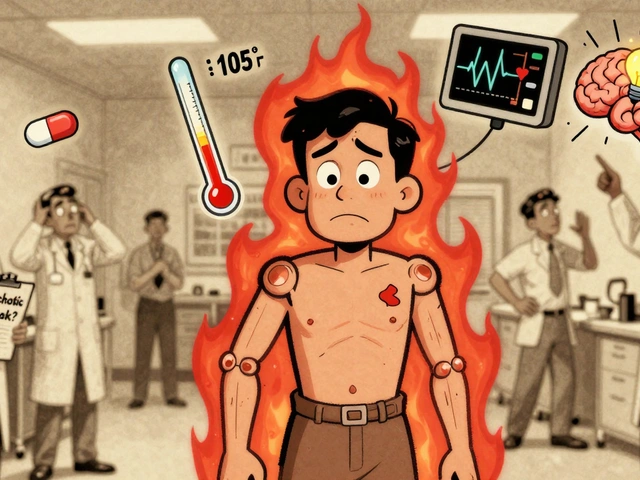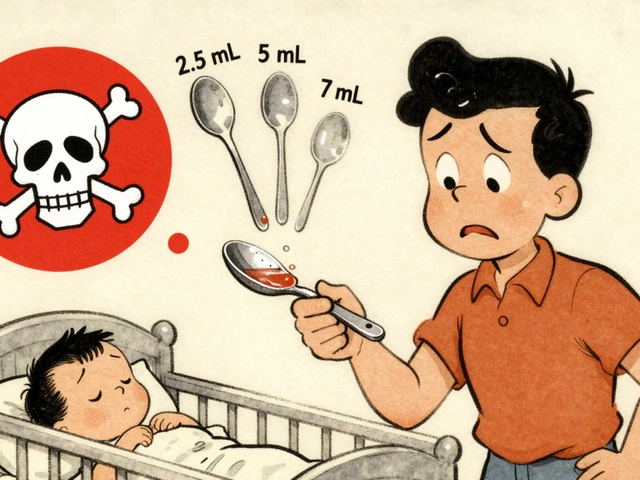INR Target Checker
Check Your INR Range
Select your medical condition to see your target INR range
Enter your condition and INR value to see if your INR is within the therapeutic range.
When you're on a blood thinner like warfarin, your life changes in quiet but powerful ways. You don't just take a pill-you track it. Every week or every month, you check a number: your INR. It’s not just a lab result. It’s the difference between staying safe and facing a stroke, or between avoiding a bleed and ending up in the hospital. Understanding what your INR means-and how to keep it where it needs to be-isn’t optional. It’s survival.
What Is INR, Really?
INR stands for International Normalized Ratio. It’s a number that tells doctors how long it takes your blood to clot. This isn’t something you can guess. You can’t feel it. You can’t see it. You have to test for it. The test measures something called prothrombin time-the time it takes for your plasma to form a clot after adding certain chemicals. But here’s the catch: every lab uses different reagents. Without standardization, a result of 2.0 in one place could mean 2.5 in another. That’s dangerous.
The WHO created the INR system in 1983 to fix that. Now, no matter where you get tested, an INR of 2.5 means the same thing everywhere. It’s calculated using your actual clotting time, adjusted by something called the ISI (International Sensitivity Index), which accounts for the specific reagent used. This standardization cut medication errors by 35% in the first decade of use, according to the American Society of Hematology.
For someone not on blood thinners, a normal INR is 1.0. That’s your baseline. But if you’re on warfarin, your target isn’t 1.0. It’s higher. And that’s where things get precise.
What Should Your INR Target Be?
Your target INR isn’t one-size-fits-all. It depends on why you’re on warfarin in the first place.
- If you have atrial fibrillation or a blood clot in your leg or lung (venous thromboembolism), your target is usually 2.0 to 3.0.
- If you have a mechanical heart valve-especially in the mitral position-you need stronger thinning: 2.5 to 3.5.
- For a mechanical aortic valve, it’s typically still 2.0 to 3.0, though some cases may go slightly higher based on risk.
These ranges aren’t random. They’re based on decades of research. A 2023 study from the American Heart Association found that patients who stayed within their target range had a 42% lower risk of stroke and a 28% lower risk of major bleeding. Go below 2.0? Your risk of clotting goes up. Go above 3.0? Your risk of bleeding spikes. And it’s not linear. For every 0.5-point increase above 3.0, your risk of major bleeding rises by 27%, according to a JAMA Internal Medicine study.
There’s also something called Time in Therapeutic Range (TTR). This measures how often your INR falls within your target zone over time. Hospitals with a TTR above 65% have 42% fewer clotting events than those below 50%. That’s not a small gap. That’s life or death.
How Often Should You Test?
When you first start warfarin, you might test every few days. Your dose is being fine-tuned. Your body is adjusting. Once you’re stable, most people test once a month. But “stable” doesn’t mean “set and forget.”
Many factors can throw your INR off: a new antibiotic, a change in diet (especially leafy greens rich in vitamin K), alcohol, even a cold or flu. That’s why consistency matters. Test at the same time of day-ideally between 8 a.m. and noon-after fasting for 4 to 6 hours. Skipping meals or eating differently the day before can shift your results.
Here’s a hard truth: 38% of patients on warfarin get tested weekly when they don’t need to, according to the American College of Physicians. That’s unnecessary stress, extra costs, and wasted clinic visits. If your INR has been steady for three months and nothing else has changed in your life, monthly testing is enough.

Home Testing: Is It Worth It?
For years, INR testing meant driving to a lab, waiting in line, and getting results days later. Now, you can test at home with a finger prick.
Devices like the Abbott Acelis and Roche CoaguChek require just 10-15 microliters of blood-about one drop-and give you a result in under a minute. No more waiting 24 to 48 hours. You know your INR before lunch.
Studies show patients who test at home spend 72% of their time in the therapeutic range, compared to 58% with clinic testing. That means 34% fewer clots and 21% fewer major bleeds. It’s not magic. It’s control.
But it’s not for everyone. If you have shaky hands, poor eyesight, or trouble remembering steps, home testing can backfire. The FDA found that 25-30% of older patients struggle with the technique. One user on Reddit said, “After three years, I still miss the capillary tube one in five times. Wasting $6 strips hurts.”
Cost is another factor. The device runs around $299. Each test strip costs $5.99. Medicare Part B covers 100% of the cost for eligible patients with no deductible. Private insurance often covers it too, but you might pay 20% coinsurance and hit an annual out-of-pocket cap of $1,500 to $7,500. And yes-31% of users report initial claim denials. You’ll need your doctor to appeal.
For people with mechanical heart valves, home testing isn’t just convenient-it’s essential. One survey found 57% of these patients prefer it, saving an average of $187 per clinic visit and reducing anxiety about missing appointments.
Warfarin vs. Newer Blood Thinners
There’s a reason newer drugs like apixaban (Eliquis), rivaroxaban (Xarelto), and dabigatran (Pradaxa) are so popular. You don’t need to test INR. You don’t need to adjust doses based on food. You take them once or twice a day, and that’s it.
But here’s what most people don’t realize: warfarin is still the only option for certain people. If you have a mechanical heart valve, DOACs won’t work. If you have severe kidney disease, many DOACs are unsafe. And warfarin? It costs $4 a month. DOACs? $550 to $650.
That’s why warfarin still makes up 30% of anticoagulant prescriptions in the U.S., even though it was 70% in 2010. It’s not outdated. It’s irreplaceable for some.
DOACs have wider therapeutic windows-they’re more forgiving. Warfarin? You’re walking a tightrope. A 0.5-point swing can mean the difference between safety and danger. That’s why monitoring matters more with warfarin than with anything else.

What to Do When Your INR Is Too High or Too Low
Your INR isn’t just a number. It’s a signal.
- INR below 1.5: This means your blood is clotting too fast. You’re at risk for stroke or clotting in your legs or lungs. Call your doctor immediately. You may need to restart warfarin or even get a blood product.
- INR between 3.0 and 4.9: This is elevated. Don’t panic. Don’t skip your next dose. But do call your provider. They might hold your next dose or lower it. You might need to test again in 2-3 days.
- INR above 5.0: This is dangerous. Stop taking warfarin. Contact your doctor within 24 hours. If you’re bleeding-nosebleeds, bruising, dark stools, headaches-you may need vitamin K or even a hospital visit.
Never adjust your dose on your own. Not even by half a pill. Your doctor uses a formula based on your weight, age, diet, and recent INRs. Guessing can kill you.
The Future of INR Monitoring
The field is changing fast. In January 2023, the FDA approved the first smartphone-connected INR monitor-the Bayer CoaguChek ProConnect. It automatically sends your results to your doctor’s system with 98.7% accuracy. No more manual entry. No more missed calls.
AI tools are coming too. The INR Advisor platform, tested at Mayo Clinic, predicted the right warfarin dose change with 83% accuracy. That’s better than most human clinicians. Imagine getting a text: “Your next dose should be 3.5 mg, not 5 mg.”
But challenges remain. Rural areas have far less access to anticoagulation services. Only 35% of rural clinics offer full INR management compared to 82% in cities. That’s a growing gap. And while DOAC use is rising-projected to hit 85% of new starts by 2028-warfarin will still be needed for hundreds of thousands.
Monitoring your INR isn’t about compliance. It’s about agency. It’s about knowing your body, understanding the numbers, and taking control. You’re not just a patient. You’re the most important part of your own care team.
Key Takeaways
- Your INR is your blood’s clotting speed, standardized across all labs.
- Target ranges vary: 2.0-3.0 for most conditions, 2.5-3.5 for mechanical mitral valves.
- Test consistently-at the same time, after fasting-to reduce variability.
- Home testing improves outcomes, saves money, and reduces anxiety-but isn’t for everyone.
- Warfarin is cheaper and still essential for valve patients; DOACs don’t need INR testing.
- INR above 5.0? Stop warfarin and call your doctor. INR below 1.5? Seek help immediately.
- Time in Therapeutic Range (TTR) is the real measure of success-not single results.










Man, I’ve been on warfarin for 8 years now. Home testing changed my life. No more waiting 3 days for results. I know my INR before coffee. One time I spiked to 4.2 after eating a whole bag of kale - caught it before I turned into a human bruise. Worth every penny of those $6 strips.
Also, if you’re on a mechanical valve? Don’t even think about switching to one of those fancy DOACs. They don’t work. Period. I’ve seen friends end up in the ER because they listened to their lazy doctor.
And yeah, TTR is everything. I track mine religiously. 78% this year. That’s not luck - that’s discipline.
Ughhh… I HATE the INR game!!!
One week I’m perfect, next week I’m at 4.8 because I ate ONE spinach salad??
And why does my doctor always say ‘it’s fine’ when my INR is 3.8??
And then I have to wait TWO WEEKS for an appointment??
It’s like my life is a spreadsheet and I’m the error message.
Also, my strips cost more than my rent last month. #WarfarinLife
As someone who grew up in a family where ‘medicine’ meant herbal teas and prayer, I never thought I’d be testing my blood at home.
But after my mom had a stroke because her INR slipped under 1.5 and no one noticed - I learned. Fast.
Now I test every Monday. I track my vitamin K intake like a foodie tracking calories. I even made a little chart with colored stickers - red for too high, green for good, yellow for ‘watch it’.
It’s not just medicine. It’s a ritual. A way to honor my body after it nearly betrayed me.
And yes - I still use warfarin. DOACs don’t care about valve patients. They’re for people who want convenience, not survival.
Consistency in testing is paramount. The variability introduced by inconsistent timing, dietary fluctuations, and medication adherence directly impacts clinical outcomes. Research demonstrates that patients who maintain structured routines exhibit significantly higher Time in Therapeutic Range.
Furthermore, the economic burden of suboptimal anticoagulation management is substantial, with avoidable hospitalizations accounting for over $1.2 billion annually in the U.S. alone.
Home monitoring, while requiring initial investment, reduces long-term systemic costs and empowers patient autonomy. It is not merely a tool - it is a clinical best practice.
Okay so I just got my INR back and it’s 5.2 and I didn’t even DO anything??
I swear I ate the same damn oatmeal for three days straight!!
My wife says I’m turning into a zombie because I’m so scared to move - like if I sneeze I’ll bleed out of my ears??
Also I tried home testing but I kept poking my finger and missing the strip and now I have 12 bruised fingers and $70 worth of wasted strips.
Can someone please tell me if I’m the only one who feels like this is a horror movie??
Interesting how the article mentions rural access gaps. I’m in the Scottish Highlands - we don’t even have a lab that does INR testing. The nearest one is 70 miles away. I’ve been on warfarin for 11 years. I test monthly. I drive. I wait. I pay for petrol.
DOACs? Great for urban folks with insurance. But for people like me? Warfarin is the only option. And we’re being left behind.
It’s not about preference. It’s about survival. And the system forgets us.
Let’s be real - this whole INR thing is a psychological minefield. You’re not just managing a number, you’re managing fear. Every time I get a result, I go through the same ritual: check the number, hold my breath, Google ‘INR 3.7 symptoms’, panic for 20 minutes, then text my wife who says ‘it’s fine, you’re fine, you’re always fine’.
But here’s the thing - I’ve had two clots before I started warfarin. I’ve had two nosebleeds that wouldn’t stop after I started. So I’m stuck between two horrors.
Home testing? Yes. It helps. But the anxiety? That doesn’t go away. You don’t get a pill for that. You just learn to live with it.
And yeah - I still use warfarin. DOACs are great until you have a mechanical valve. Then you’re back to the tightrope. And you’re alone on it.
Also - vitamin K. Don’t underestimate it. One avocado and my INR drops like a rock. One salad and I’m in panic mode. It’s not just medicine. It’s a dietitian’s nightmare.
The INR is a metric born of statistical necessity, not biological intuition. It reduces the complexity of hemostasis to a single scalar - a reductionist abstraction that, while clinically useful, obscures the individual variability of coagulation dynamics.
One might argue that the pursuit of a ‘target range’ is a form of medical dogma - a quantified illusion of control over a system inherently probabilistic and context-dependent.
And yet - we cling to it. Not because it is perfect - but because it is the best tool we have. In this, warfarin becomes less a drug and more a mirror - reflecting our collective desire to quantify the unquantifiable.
Perhaps the real therapy is not the INR - but the discipline it demands.
Just wanted to add something important - if you’re on warfarin and your INR is above 5.0, don’t just ‘call your doctor’ - call 911 if you’re bleeding or have a headache. I had a friend who waited 12 hours to call because he thought ‘it’s not that bad’ - ended up with a brain bleed. He’s fine now, but barely.
Also - vitamin K is your friend. Keep it on hand. I keep a 5mg tablet in my wallet. If my INR hits 4.5 and I can’t get to a clinic in time? I take half. Not because I’m reckless - because I’ve been trained. My anticoagulation clinic gave me a printed card with dosing guidelines.
And yes - home testing is worth it. I’ve saved over $3,000 in clinic fees in two years. And I sleep better.
Oh - and if your insurance denies your device? Keep appealing. I got mine approved after 3 denials and one very angry phone call to my doctor’s office. They finally sent the letter. Don’t give up.
Bro, I’m from Mumbai and I’ve been on warfarin for 6 years. We don’t have home testing here - no way. My clinic is 2 hours away. I go every 3 weeks. I bring my own blood pressure monitor, my own notebook - I’m the only one who tracks my diet.
My doctor? He doesn’t even know what vitamin K is. He just says ‘take your pill’. So I’ve become my own doctor.
And yeah - I eat a lot of dal and rice. No greens. No spinach. No kale. I don’t care what the trend says - my INR doesn’t care about your Instagram salad.
Also - warfarin costs me $2 a month. DOACs? $500. I’d rather test my blood than pay that.
Don’t let anyone tell you it’s outdated. It’s just… misunderstood.
My dad’s on warfarin. He’s 72. He hates the finger pricks. But he does it. Every Monday. He says it’s the only thing keeping him alive after his valve surgery.
He doesn’t have a home tester. He takes the bus. Gets there at 7am. Waits 45 minutes. Comes home. Takes a nap.
He never complains. But I see him staring at the paper with the number. Sometimes he smiles. Sometimes he just sighs.
That number? It’s not just a number. It’s his heartbeat on paper.
There’s a quiet dignity in monitoring your own INR. It’s not glamorous. No one posts about it on TikTok. But it’s the most honest kind of self-care - no influencers, no trends, just you, a drop of blood, and the quiet understanding that your life depends on this tiny, fragile balance.
I used to think medicine was about pills and procedures. Now I know it’s about discipline. About showing up. About remembering to eat the same breakfast. About not letting a cold throw you off.
Warfarin isn’t outdated. It’s ancient wisdom wrapped in modern science. And for those of us who need it? It’s sacred.
Ugh. Americans and their home testing. We have universal healthcare here in Canada - we don’t need to pay $6 for a strip. We just go to the clinic. It’s free. Why are you all so obsessed with DIY medicine?
Also - DOACs are better. Why are you still clinging to this 1940s drug? It’s like using a flip phone in 2025.
Warfarin is for people who can’t handle modern medicine. And honestly? You’re lucky you even have access to it.
My INR was 4.7 last week. I didn’t tell anyone. I just skipped my dose and waited. It went down to 3.1 in three days.
I didn’t want to bother my doctor. I didn’t want to be ‘that guy’ who calls every time his number changes.
But I still worry. Every time I feel a headache. Every time I see a bruise.
I think I’m doing okay. But I don’t know.
Thanks for the article. It helped me feel less alone.
^ That’s exactly why you don’t do that. I did the same thing once. Thought I was fine. Next thing I know - I’m in the ER with a subdural hematoma.
Don’t be the guy who ‘waits it out’. Call your doctor. Even if it’s 2am. Even if you think you’re overreacting.
That’s the whole point of this whole system - you’re not supposed to guess. You’re supposed to call. And get help.
And yeah - I still do home testing. But I call my anticoagulation nurse every time I’m over 4.0. No exceptions.
Survival isn’t about being brave. It’s about being smart.